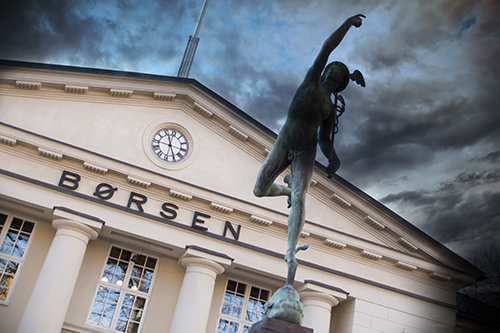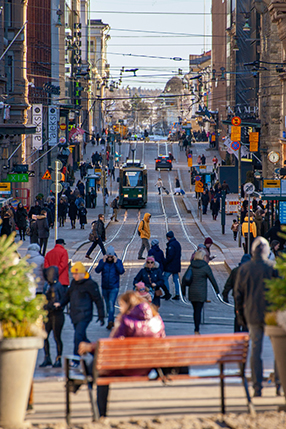The 'Nordic model' of capitalism
The five Nordic countries (Denmark, Finland, Iceland, Norway and Sweden) are often characterised as being welfare capitalist, featuring a combination of free market activity and government intervention. However, the institutional frameworks and economic policy models have changed over time, and the ‘model’ used has varied between countries and throughout their history. The success of the Nordic economies has arguably shown that economic prosperity can go hand in hand with the welfare state. Current challenges include increasing wage differentials and an ageing population, however.

Institutional settings in the Nordic countries are fairly similar, due to their close cultural and historical roots. The Nordics are often characterised as welfare capitalist countries, featuring a combination of free market activity and government intervention. The institutional framework has changed over the course of time, however. In the post-war decades, many sectors of the economy, such as the financial markets, were highly regulated in all the Nordic countries. Economic planning and steering were at the fore in order to modernise the economy and promote growth. This changed radically in the 1980s and 1990s when a paradigm shift occurred, affecting both economic policy and institutional models. Market-based solutions were adopted, and the emphasis in economic policy, which had primarily been based on aggregate demand and/or investments, was transferred to monetary stability.
Not just one ‘Nordic’ or ‘Scandinavian’ economic model
The models have varied between the individual countries as well. In Finland and Sweden, top-down policies and direct intervention have been prevalent, and at times the state has been both strong and active. The state’s role in infrastructural investment has occasionally been significant and active growth policies have been prominent. In Finland, Norway and Sweden state-owned companies have had an important role. The Nordic model should, however, not be considered to be the same as a strong state and/or interventionist economic policy. Denmark can, moreover, be characterised as a more liberal economy, in which direct state interventions have been less common. Since the 1990s direct state intervention and regulation have decreased radically and in the wake of the international trend for privatisation since the 1990s, privatisation of state companies has occurred in the Nordic countries.
Economic policy models have varied over time
The adoption of economic policy models have varied over time, too. For example, Sweden and Denmark explicitly adopted the Keynesian model in the post-war period, while Finland’s economic policy focused more on promoting growth by keeping the investment rate high and expanding the export sector. The promotion of industrialisation was also important in Norway. In Sweden and Finland problems of competitiveness were, on the other hand, often solved by resorting to devaluations. The Nordic countries have been characterised by a certain amount of pragmatism in economic policy.

The Nordic model should not be considered to be the same as a strong state and/or interventionist economic policy. Aleksanterinkatu, Helsinki, Finland. Photo: Tapio Haaja, Unsplash.
The welfare state as the cornerstone of Nordic economic development
Internationally the ‘Nordic model’ is often considered to mean welfare states and consensual policies in the labour market. The welfare state has been an important cornerstone in Nordic economic development, and during the post-war decades collective wage bargaining and policies to preserve peace in the labour market were common. Collaboration and co-ordination were key words. Although the development of the welfare state meant growing taxes and an expanding public sector, it also increased participation in gainful employment, especially among women. Investment in education has been a key goal in the Nordic countries and as a result the population has attained a high level of education. The labour supply has also been favoured by extensive immigration, particularly in Sweden and Denmark. Since the 1990s the proportion of foreigners in the labour force has increased in Finland and Norway too.
The Nordics: countries with small income differentials
Wage and income differentials have been small in the post-war period in the Nordic countries. This was partly a result of active policies. Since the 1990s income differentials have, however, shown a tendency to grow again. This is mainly due to the growing share of capital incomes, which tend to grow faster than salaries, while wage differentials are still fairly small. These trends are also a result of changes in labour market, however. Temporary labour contracts have become more common, and wage setting has become more decentralised. A paradigm shift during the 1980s towards liberalisation and deregulation, and the financial crises of the 1990s also changed the role of the welfare state in the Nordic countries. Social benefits were reduced to promote incentives to seek employment. The tax burden was reduced and the public sector slimmed. As a consequence, public spending as a share of GDP has shrunk in the Nordic countries. For instance, in Sweden, where the public spending’s share of GDP was for a long time one of the highest in the world, the share has been reduced to just over 50% of GDP in 2019 (compared with, for example, the UK and Japan, where it is 42.2% and 39.4% respectively (2015 figures)).
'slush' is a widely acclaimed international conference for entrepreneurs and start-up businesses held in Helsinki annually. www.slush.org.
|
The welfare state can support economic growth
Despite public spending being reduced, the welfare state still holds a deep-rooted position in the Nordic societies. Research has also shown that a generous welfare state is not necessarily in conflict with economic prosperity, but that it can actually support economic growth. The Nordic countries provide a good example of welfare states, which, together with well-developed educational systems, have provided the economy with a highly educated and generally healthy labour force that is integrated in the labour market. This has boosted overall development. The investment role of the state can also be significant. Investments in education and technology, the promotion of innovation, and technological and organisational renewal have used up more public resources during recent decades than previously; these are seen as important for enhancing growth in the future.
Future challenges to Nordic economies
Previous success is, however, never a guarantee for future success. Common to all the Nordic economies are challenges such as an ageing population, and the prolonged economic crises in Europe.
Further reading:
- Gudmundur Jonsson, ed., Nordic Historical National Accounts (Reykjavík: University of Iceland Press, 2008).
- Per Hull Kristensen and Kari Lilja, eds., Nordic Capitalisms and Globalization: New Forms of Economic Organization and Welfare Institutions (Oxford: Oxford University Press, 2011).
- Steffen Andersen, The Evolution of Nordic Finance (Basingstoke: Palgrave Macmillan, 2011).
- Susanna Fellman, Martin Jes Iversen, Hans Sjögren and Lars Thue, eds., Creating Nordic Capitalism – The Development of a Competitive Periphery (Basingstoke: Palgrave Macmillan, 2008).
- Torben M. Andersen, Bengt Holmström, Seppo Honkapohja, Sixten Korkman, Hans Tson Söderström and Juhana Vartiainen The Nordic Model. Embracing globalization and sharing risks (ETLA B232, 2007).